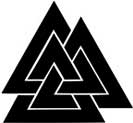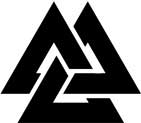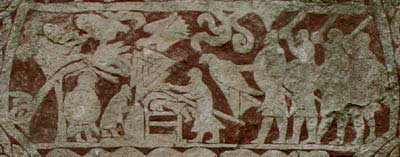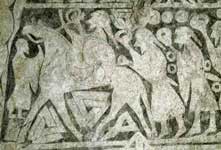The word valknut is a neologism: it is formed in modern times through combination of ON valr, ‘the dead’ or ‘the slain’ and knut, ‘knot’. Valknut is a Viking symbol of three interconnected triangles. The triangles may be joined in two ways: either as Borromean:

or unicursal:

Note that other types of valknuts, such as closed three-link chain, never occur in the original Viking ornaments. One should keep that in mind when using the valknut in Viking tattoos or runic tattoos, since only the above two designs are genuine Viking valknuts. Consider the Borromean triangles type, which occurs on the Stora Hammar rune stone.

Here above the valknut we see a raven, Odin’s symbol. Below the valknut is probably a burial mound. A dead warrior is put there by someone with a spear and accompanied by another raven. The spear is probably Gungnir, Odin’s weapon. The other sign of Odin’s presence is a warrior hanged on a tree to the left of the mound. All the symbols around the valknut, which is in the central position here, point to death and to Odin as a god of slain warriors.
The unicursal type of valknut (which can be drawn with one stroke) appears on Tängelgarda stone:

Other instances of the valknut in Viking ornaments are Lärbro stone, River Nene ring and a bedpost found on the Oseberg ship.
However, knot of the slain is not the only possible interpretation of the valknut. It is also called Hrungnir’s heart. This name is based on a description found in the Prose Edda:
“Hrungnir had a heart that was famous. It was made of hard stone with three sharp-pointed corners just like the carved symbol Hrungnir’s Heart (hrungnishjarta).”
The original meaning and function of the valknut is not wholly clear. The number three is a very common magic symbol in many cultures. However, in Scandinavian context three multiplied by three might designate the nine worlds, which are united by the Yggdrasil tree. In modern times Valknut, like Triquetra and Horn Triskelion, is often interpreted as a symbol pointing to heathen convictions.
Copyright notice: Valknut images above are by © The Viking Rune. Images of Stora Hammar and Tängelgarda stones are public domain.

As for Tattoos> Celts settled on the northern shores of continental europe, Northern France, Belgium, Netherlands… and the tip of Denmark where the Picts were settled aside the south and northern tips of great britain believed in tattooing their bodies with a particular blue pigment presumably emulating a dead body or a corpse come from death, likely to inflict fear and terror in rivals. Nobody can confirm exactly if there was NO tattoing at all in the viking era but they were certainly aware to say the least of it, being the travellers they were and having dealt with almost all the trading cultures on the planet of the time. I have heard that viking warriors would either paint but also likely tatto BIG eyes on their biceps as to distract oponents while the lifting of an axe in battle, but this could also be accounted for the Berseerkers… so there lays the benefit of the doubt…
On the matter of Hrungnir’s valknut, Hrungnir rises as a challenger to Odin to race his stallion XXXX *(Gullthroppr…?) versus Sleipnir (Loki’s gift to Odin) leaving Odin to win the race. Hrungnir is invited to drink meadd at the Valhall and gets violently innebriated when Thor is called upon and kills Hrungnir. The Valknut is the shape of the heart of Hrungnir which could also be interpreted as the cut made on the chest so as to retrieve the Heart… as would someone do in an autopsy nowadays.
Hello Lucas. We know for sure that Vikings had tattoos. This is attested by Ibn Fadlan, a 10th century Arab traveller.
Is there a difference in meaning or significance between the two variations of the valknut ?
Helo Noah. We don’t know.
The Valknut to my understanding is a warriors symbol. When the Valkarye visit the battlefield of slain warriors to take to Vahalla they look for the Valknut. It was worn or tattooed on the warrior.
Hello JoAnn. As far as I know, there are no sources that speak about Valknut being tattoed on warriors’ skin.
The symbol of odin, wotan, vod, to bind and/ or unbind the minds of warriors in battle, to give the wearer the ability to penetrate the mystery and reweave their destiny. to control their death, or life to the extension of gaining glory in battle. I wear one on each hand, one is unicursal, the other is triple triangle knot. with seidr may the seed of odin be glorious in battle, lo’ there do I see my Father? ;-p
Hello Jaq. Your interpretation is interesting.
First, I have to say I love your website, you’ve done a great work! I explain my case. I want to tattoo the valknut and a phrase that says something about who goes to valhalla. I read in one of your articles that the best way not to make a mystake is founding a quote in some Edda or runic stone. well, i only found this in GRIMNISMOL (Poetic Edda):
“The fifth is Glathsheim, | and gold-bright there
Stands Valhall stretching wide;
And there does Othin | each day choose
The men who have fallen in fight.”
I want to know, what it is the best way to make me the tattoo?
write it in old norse like in the edda?or converts it into runes?
And one more question, can I translate into eldar futhark with the rune converter: valhalla I am coming?
thanks for your great work!!
Hello Pablo. You can either choose Old Norse text in Roman letters, or Old Norse in runes, or else English text in runes. All those options are fairly legitimate. There is no universally accepted standard that would forbid any use.
Yes, you can use the rune converter to write this phrase in the Elder Futhark runes. Note that the converter does not translate anything into Old Norse or any other language. It substitutes letters for various types of runes.
I make this symbols in lime stone.
Hello Wim. Interesting! Could you share a photo with us?
For one Valknut is a modern name. Second I find it funny no one ever points out its a symbol of the Norns/Wyrd Sisters, weavers of the Wyrda of things. Second Val means Fall but also Choose so its context based.
Hello. The article above begins with the statement that the word Valknut is a neologism. As for your interpretation of the symbl’s meaning, it is, of course, possible, but not historical.
Hi
I am wondering if there is a single Rune sign that represent the two raven Huginn and Muninn?
Look very forward to hear from you.
The very best
C
Hello Cecilia. There is no such rune.
Can anybody find the norse/ viking symbols for family, father, mother and son it would be a real help thank you
Hello Daniel. I am not aware of such symbols.
It’s related to the druid triangles. Time travel,reincarnation,rebirth and commune with the Gods. A tattoo on a warrior was believed to call out to Valhala when he or she fell in battle or any other death that was honorable.
Hello Gary. Time travel sounds especially fascinating.